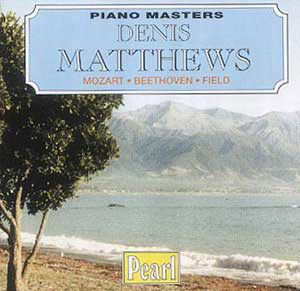Matthews was born in 1919 and studied piano with Harold
Craxton and composition with William Alwyn at the Royal Academy of Music
from 1935-40. He made his London debut at the age of nineteen under
the indefatigable Henry Wood and wartime exigencies led to opportunities
to record for Walter Legge – always on the lookout during the War for
talented young musicians to consolidate the domestic catalogue – at
Columbia. Jeremy Nicholas’ sleevenote emphasises Matthew’s directness
and simplicity and these are indeed characteristics of his pianism though
not ones that imply superficiality or fatal lack of engagement as they
might in other hands.
When these recordings were made Matthews was in his
mid twenties, one of the youngest pianists in a field that included
Mozartians and Beethovenians of such eminence as Solomon, Curzon, Hess
and Kathleen Long. It’s a pity that Pearl doesn’t go into any great
depth about the early Matthews discs as the details aren’t hard to find
and nor are the exact recording dates, which aren’t noted either. Matthews
went to EMI Abbey Road in July 1941 to record the Bach English Suite
No 2, the Beethoven C Minor Variations G191 and Op 119 Bagatelles [Nos
1 and 11] – in the event none was issued. Next month he returned and
successfully completed the recordings. The Fantasia and Fugue on this
Pearl was therefore one of his earliest discs – September 16, 1942,
closely followed by his famous "emergency learn" of the Rawsthorne
Bagatelles used as a fill up to the Moeran Symphony recording with the
Hallé and Heward. His prowess and esteem as a chamber player
were cemented early with celebrated recording of the Beethoven Horn
Sonata with his friend Dennis Brain and the Clarinet Trio with Reginald
Kell and Anthony Pini. K488 was recorded with Britain’s leading wartime
orchestra, the Liverpool Philharmonic, on August 28 1944 in Philharmonic
Hall. It was a busy month for Legge. He also managed to record Boult
in Elgar’s Second Symphony, Solomon and Boult in Beethoven’s Third Piano
Concerto, Moiseiwitsch and Weldon in Tchaikovsky’s Second Concerto (the
day after this Matthews traversal, same orchestra) and Heddle Nash in
some arias.
The conductor for the Mozart was to have been Sargent
but his daughter, Pamela, died and Weldon took over at short notice.
The balance slightly favours the orchestra, with the piano sounding
very slightly recessed and veiled, though Matthews himself is full of
clarity and intelligence. In the first movement his diminuendos are
chastely appropriate and he never imposes large dynamic ranges on the
music – there is a scaled equilibrium to his playing that is winningly
attractive. There is also an unadorned gravity, a wise simplicity to
his way with the adagio – an aptly withdrawn sensibility and in the
finale there is again no over emphases or theatrical fillips or flourishes
to mar the line. His duetting with the orchestral wind principals has
a chamber intimacy all its own. (A decade or so later Matthews re-recorded
the Concerto with the Philharmonia and Rudolf Schwarz, again supervised
by Legge). In the Sonata K310 he is more than adequately assertive but
doesn’t take the repeat – or maybe wasn’t encouraged to given shellac
shortages. I found some of his phrasing in the flowing slow movement
just a little strait laced though, an occasion where his simplicity
and honesty elided rather more into lack of engagement. In the Fantasie
and fugue he is not quite the equal of such as, say, Paul Badura-Skoda,
but is still impressive in its refined imagination. I enjoyed the unaffected
directness of the Op 109 E Major Sonata. As expected he brings an affecting
and unselfconscious rightness to the final movement’s adagio introduction
and a surety to the variational passages. He is also in the best traditions
of Field playing in the Nocturne especially.
Much here is of a refined pianism; if it seems aloof
it’s in the interests of structural integrity; if dynamics are restricted
it’s the better to serve the work’s emotional profile. Matthews took
his own life after a period of manic depression in 1988, having long
since given up a performing career in favour of teaching and lecturing.
To what extent this was – as Pearl asserts in its jewel case – a "tragic
early death" (Matthews was 69) is debatable (tragic, yes – early,
no) but his playing on record, as presented here, preserves playing
of maturity and insight.
Jonathan Woolf


